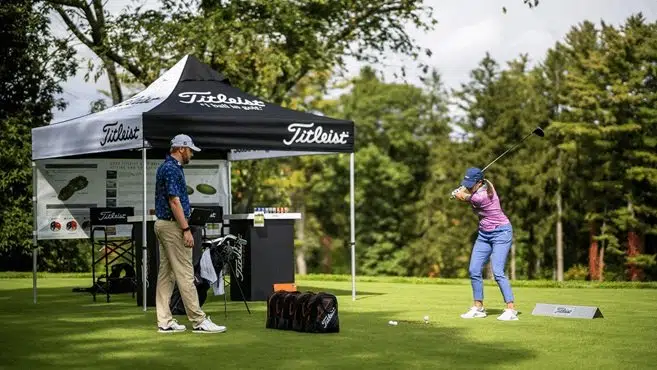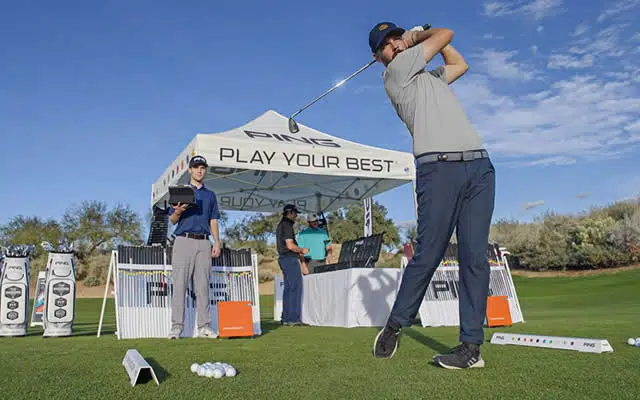Your golf swing is like a set of fingerprints – it is unique to your DNA and no-one, even the best impressionists in the world, can mimic it exactly.
Because of this, it makes zero sense to apply a ‘one size fits all’ approach to golfers when it comes to setting them up with the perfect set of clubs.
Some players stand closer to the ball with the toe down, while other players have the toe pointed more upwards at address; similarly, some players stand the shaft up more at impact, while others don’t.
These subtle traits that make your swing unique to you create slight differences to how you deliver the club onto the back of the golf ball, and it’s why fittings are so important if you’re serious about milking every last drop of potential out of your ability.
So, before we dive right into what club fittings entail and how they can improve your performance, let me first provide a no-nonsense answer to the number one question you’ll have on this topic.
Table of contents
Is it worth getting my golf clubs fitted?
Yes, it is absolutely worth getting your golf clubs fitted. A professional fitter will assess your swing speed, launch angle and lie angle at impact and then give you clubs that will produce the optimal flight numbers for your customised swing characteristics.
If you are buying a new set of clubs, it is absolutely essential you get fitted correctly.
As I mentioned at the start of this article, everybody swings the club slightly differently and you may be leaving heaps of shots out on the course if you’re using wedges, irons, hybrids, fairway woods or drivers that are not ideal for your game.
Club fitters are professionally trained to look at the data – usually after you’ve hit some balls on a Trackman flight simulator – and then make recommendations based on those statistics.
So, while it may not be worth getting fitted for a second-hand set, if you’re planning on buying brand-new then you’d be crazy not to participate in a proper fitting session before making your choice.
What happens during a golf club fitting?
During a golf club fitting, a professional fitter will have you hit balls on a Trackman (or similar) flight simulator. They will assess your swing speed, launch angles and lie angles and have you test clubs with different head shapes, lofts and shaft flex to try and create optimal flight data.
For example, if your tendency is to hit low stingers with your short irons, the fitter may get you to test some clubs with more natural loft.
If your swing speed is well over 100mph, they may swap out the shaft for something that is stiff or extra stiff to try and tighten your shot dispersion and increase distance.
But in summary, below is a quick rundown of what you can expect during a typical fitting (this is the process I went through before landing on my new Srixon ZX7 irons).
Do your research before booking a fitting
Before you even arrive for your club fitting, it’s important to have done some research on the kind of clubs you’d like to try as this will give you and the fitter a good starting point to work from.
You may, for example, have your heart set on a new set of Callaway Apex 21 irons, but after hitting a few realise they don’t produce optimal Trackman numbers for your game.
Bring your current set of clubs with you
When the time comes for your fitting, make sure you bring the set of clubs you are currently using with you.
Once the session begins, your club fitter will get you to hit a few shots using these clubs (likely a wedge, short iron, mid/long iron and driver) and then use that data as the ‘base numbers’ upon which to compare the newer clubs with.
They will also be able to see where the existing deficiencies are with your current clubs.
Undertake a pre-fitting interview
Before you even hit a single ball, your fitter will likely ask you a few questions to gauge how your current clubs are performing (and determine what is working well, and what isn’t).
They’ll likely ask you to rate how well you’re currently striking the ball, what your ‘miss’ is (right, left, fat or thin) and also what you like/dislike about your existing set of clubs.
You can see the guys from GolfTec ask these kinds of questions during a golf club fitting for the guys from GM Golf in the video below:
Fitting begins, aided by Trackman
After all these pre-fitting steps are completed, it will be time to start the session.
Your fitter will have you hit wedges, irons and driver depending on what you’re getting fitted for, and assess the data from each shot via Trackman (or another similar flight simulator like FlightScope).
This data will tell them everything they need to know about your swing – including swing speed, launch, lie angle and spin – and allow them to recommend clubs for you to hit that will produce the best-possible Trackman numbers.
Typically, you’ll hit five or six different models and begin eliminating them one-by-one until you narrow it down to the perfect set for your swing.
Assess lie angle
Once you’ve landed on your ideal set of clubs, the last thing to check is lie angle (which determines whether you deliver the club toe-down, toe-up or neutral at impact).
The way your fitter will do this is by applying a thin strip of tape to the sole of the clubhead – this obviously only applies to clubs that make contact with the turf – and then getting you to hit some shots.
If a mark is made consistently towards the heel of the club, you’ll need a clubhead that is bent one or two degrees toe down; similarly, if the mark is consistently towards the toe of the club, you’ll need a clubhead that is one or degrees toe-up.
The aim is to move the mark towards the centre of sole, which means you’re delivering a neutral lie angle at impact – this will give you the best possible chance of hitting straight shots, with little to no curvature.
How much does it cost to get fitted for golf clubs?
Some golf outlets, such as Drummond Golf in Australia, will not charge you anything for a professional club fitting. Other outlets may charge you up to $100 or more for a fitting. It’s best to shop around as many places offer fittings as a complimentary service when buying a new set of clubs.
In Australia, the country’s largest golf manufacturer – Drummond Golf – conduct fittings using their advanced ‘MiMatch’ system, without charging you a cent.
For this reason, you’d be mad not to get yourself fitted for clubs before purchasing them!
How often should you get your golf clubs fitted?
You should definitely get fitted before buying a new set of golf clubs. With golf technology constantly changing, it’s ideal for amateurs to upgrade their irons around every five years – and you should get fitted each time you do so.
As I’ve written in another article, golf irons can wear out after a number of years – particularly the grooves – if you play regularly.
Similarly, technology used to manufacture golf clubs is advancing rapidly year-after-year, so a set of clubs that is five or more years old may mean you’re not taking advantage of the latest game improvement designs built-in to the newest-model clubs.

Should a beginner be fitted for golf clubs?
Absolutely. A beginner, like a low handicapper, can benefit greatly from a proper golf club fitting. It will get them using the correct clubs from the get-go, which will help them improve far quicker and bring their handicap down faster.
Some people say you shouldn’t bother with a fitting until you’re down to a mid-handicap range, but I couldn’t disagree more.
As a beginner, you need all the help you can get, so it makes sense then that a proper fitting can set you up for the best chance of success.
And, if you do improve, and your swing begins to change, you can always return and get re-fitted at a later date and upgrade your clubs if required.
Can you get irons fitted after buying them?
If you have irons with removable heads, you can get them refitted for shafts at a later date. However, in terms of changing lie angles, this can be harder to do if you’re not using forged irons. Even if you are, you may only be able to bend the lie angle by one or two degrees.
If you’re using an old set of irons, it’s probably not worth the effort to get them fitted.
In most cases, it’s best to undertake a full fitting session when you’re ready to buy a new set of clubs that will last you at least the next five years.
Is it worth getting a driver fitted?
Absolutely. Driver is one of the most important, and expensive, clubs in your bag so it’s very important to get fitted for one that matches your swing. With a fitted driver, you should be able to hit the ball longer, straighter and reduce your scores as a result.
A driver fitting will be carried out in the exact same way as a wedge or iron fitting, minus the lie angle tape because of the fact your driver doesn’t make contact with the turf at impact (unless, of course, you’re hitting it off the deck to try and reach a long Par 5 in two).
Aside from your putter, I’d argue that driver is the most essential club you can hit – because if you hit it well, you’ll leave yourself with a short iron or wedge into most greens, leading to more pars and birdies.
A professional club fitter will make sure you select a driver that has the correct shaft and produces the optimal launch and spin rate to give you the best possible results.
Final message
If you’re thinking of buying a new set of clubs, I cannot stress how important it is to undertake a club fitting.
A professional fitter will be able to assess your swing, analyse the key data, and present you with the best options to choose from that will give you optimal results.
Like a tailored suit, fitted clubs will have you looking good, feeling great and give you the confidence you need to go low out on the course.
- TaylorMade SIM2 Max Driver vs M4 Driver: Worth it in 2024? - April 15, 2024
- 3 Ways to Win the Mental Game with the Bridgestone Mindset Golf Ball - March 29, 2024
- TaylorMade SIM Max & SIM2 Max Drivers: Are they Still Relevant in 2024? - March 9, 2024


